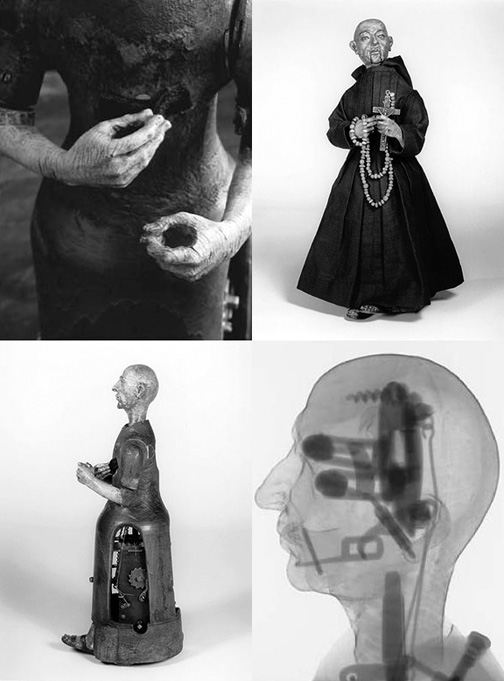Skynet Has Infiltrated the Past

Remember learning in school about how the Middle Ages were a time without intelligence, technology or a sense of humor? Consider the curious case of Juanelo Turriano’s (AD 1500-1585) mechanical monk, described here by Elizabeth King:
Slowly the monk comes to life. He turns his head to single out one among the company. Left foot stepping forth from under the cassock hem, then right foot, the monk advances in the direction of his gaze, raising the crucifix and rosary before him as he walks. His eyes move: turning his head, he looks to the raised cross and back to his subject. His mouth opens, then closes, affording a glimpse of teeth and interior. He bends his right arm and with the gathered fingers of his hand he strikes his breast. The small blow is audible. And now he is lowering and turning his head as he walks: the elbow and shoulder in synchronized motion he brings the cross higher, up to his lips, and kisses it. Thirty seconds into the act, he’s taken eight steps, beat his chest three times, kissed the cross, and traveled a distance of twenty inches. At what seems like the last moment—for doubtless the subject of his attention has backed away from the table’s edge—he looks away, arms still aloft, executes a turn to his right, and makes a new appointment. He will make seven such turns and advances in his campaign if the mainspring has been fully wound. The uninterrupted repetition corresponds exactly to a trance-like performance of prayer, incantation.
Found at The Lion and the Cardinal.



















 Full Details
Full Details


4 Comments
This is too cool! I found a video on YouTube showing the monk in action: http://www.youtube.com/watch?v=ixm7tuO3QsY Would love to have a replica of this.
Awesome! I’m wondering if perhaps it wasn’t Connie Willis’ protagonists from her various Cambridge Time Travel universe storylines who may have played a part here 🙂
The video is really cool, yet kind of creepy. I think it’d be cool to see a replica of it with a modern day twist; perhaps put some artificial intelligence behind it with WiFi and cameras for eyes?
Yeah, the only thing keeping the AI apocalypse from happening during the Renaissance was that these things could only network with each other via messenger pigeons and cans on REALLY long strings. Message 1: "Kill all humans," Message 2:"When?" Message 3: "Tomorrow" "Message 4: "These messages take 3 weeks to get here, what do you mean by "tomorrow," your tomorrow or mine?" Message 5: "What?" Message 6: *Intercepted by bandits* If you’re interested in this, check out The Turk, a chess-playing automaton that played and beat the likes of Napoleon (Bonaparte, not Dynamite) and Ben Franklin. Of course it wasn’t REALLY an automaton, but it did a good job of convincing people that it was completely run by springs and clockwork. It’s story is an interesting example of how people dealt with the idea of an AI in the 18th and 19th century. Tom Standage wrote a history of the machine and a novelist named Robert Lohr wrote a novel about it titled The Secrets of the Chess Machine.
Sorry, the comment form is closed at this time.